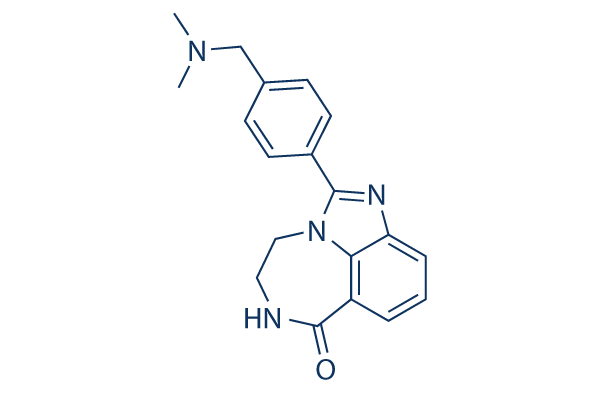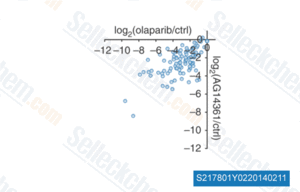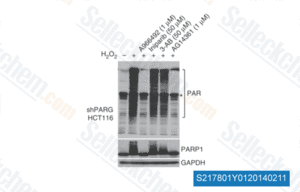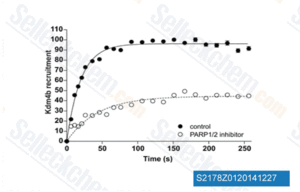|
受注:045-509-1970 |
技術サポート:[email protected] 平日9:00〜18:00 1営業日以内にご連絡を差し上げます |
化学情報

|
Synonyms | N/A | Storage (From the date of receipt) |
3 years -20°C powder 1 years -80°C in solvent |
| 化学式 | C19H20N4O |
|||
| 分子量 | 320.39 | CAS No. | 328543-09-5 | |
| Solubility (25°C)* | 体外 | DMSO | 51 mg/mL (159.18 mM) | |
| Ethanol | 21 mg/mL (65.54 mM) | |||
| Water | Insoluble | |||
|
* <1 mg/ml means slightly soluble or insoluble. * Please note that Selleck tests the solubility of all compounds in-house, and the actual solubility may differ slightly from published values. This is normal and is due to slight batch-to-batch variations. |
||||
溶剤液(一定の濃度)を調合する
生物活性
| 製品説明 | AG14361 is a potent inhibitor of PARP1 with Ki of <5 nM in a cell-free assay. It is at least 1000-fold more potent than the benzamides. |
|---|---|
| in vitro | AG14361 is at least 1000-fold more potent than the benzamides. The IC50 for AG14361 is 29 nM in permeabilized SW620 cells and 14 nM in intact SW620 cells. Crystallographic analysis of AG14361 bound to the catalytic domain of chicken PARP-1 shows that the tricyclic ring system of AG14361 is located in a pocket composed of amino acid residues Trp861, His862, Gly863, Tyr896, Phe897, Ala898, Lys903, Ser904, Tyr907, and Glu988. AG14361 forms important hydrogen bonds with Ser904 and Gly863 and a water-mediated hydrogen bond with Glu988. AG14361-induced growth inhibition is not attributed to PARP-1-related effects because maximal PARP-1 inhibition is observed at much lower concentrations (≤1 μM) than the GI50. AG14361 at 0.4 μM does not affect cancer cell gene expression or growth, but it increases the antiproliferative activity of temozolomide and topotecan, and inhibits recovery from potentially lethal γ-radiation damage in LoVo cells by 73%. In addition, 0.4 μM AG14361 does not substantially alter gene expression as shown by microarray analysis. A 17-hour exposure of A549 cells to 0.4 μM AG14361 does not change the expression of the 6800 genes. Thus, although 0.4 μM AG14361 inhibits cellular PARP-1 activity by more than 85%, it essentially does not change gene expression and cell proliferation, indicating that the cellular effects of this low concentration of AG14361 are specific for PARP-1 inhibition. Higher, growth-inhibitory concentrations of AG14361 affects gene expression, but these effects are not likely to be related to PARP-1 inhibition because cell proliferation is affected equally in PARP-/- and PARP-1+/+ cells. AG14361 is rapidly absorbed into the bloodstream and distributed to the tumor and liver with lower concentrations detected in the brain. Tissue-to-plasma concentration ratio indicates that AG14361 is retained in tumor tissue over time in both xenograft models, with tumor concentrations (≥15 μM for 2 hours) in excess of that required to inhibit PARP-1 activity in vitro. [1] AG14361 enhances temozolomide activity in all MMR-proficient cells (1.5–3.3-fold) but is more effective in MMR-deficient cells (3.7–5.2-fold potentiation), overcoming temozolomide resistance. In contrast, benzylguanine only increases the efficacy of temozolomide in MMR-proficient cells but is ineffective in MMR-deficient cells. [2] AG14361 enhances the growth-inhibitory and cytotoxic effects of topoisomerase I poisons. AG14361 increases the persistence of camptothecin-induced DNA single-strand breaks. [3] |
| in vivo | AG14361 treatment before irradiation statistically significantly increases the sensitivity to radiation therapy of mice bearing LoVo xenografts. AG14361 statistically significantly increases blood flow in xenografts and thus potentially increases drug delivery to tumor xenografts. In vivo, nontoxic doses of AG14361 increases the delay of LoVo xenograft growth induced by irinotecan, x-irradiation, or temozolomide by 2- to 3-fold. Coadministration of AG14361 with temozolomide statistically significantly increases temozolomide activity against LoVo xenografts, with the tumor growth delay being increased from 3 days to 9 days by AG14361 at 5 mg/kg and to 10 days by AG14361 at 15 mg/kg. The combination of AG14361 and temozolomide causes complete regression of SW620 xenograft tumors. PARP-1 activity, detected by pharmacodynamic assay, in SW620 xenografts is inhibited by more than 75% for at least 4 hours after intraperitoneal administration of AG14361 (10 mg/kg), consistent with the concentration of AG14361 persisting in the tumor. [1] |
| 特徴 | The 1st high-potency PARP-1 inhibitor with the specificity & in vivo activity to enhance chemotherapy and radiation therapy of human cancers. |
プロトコル(参考用のみ)
| キナーゼアッセイ | PARP-1 Activity Assays | |
|---|---|---|
| The activity of full-length recombinant human PARP-1 is measured in a reaction mixture containing 20 nM PARP-1, 500 μM NAD+ plus [32P]NAD+ (0.1–0.3 μCi per reaction mixture), and activated calf thymus DNA (10 μg/mL) at 25oC; the reaction is terminated after 4 minutes by adding ice-cold 10% (wt/vol) trichloroacetic acid. The reaction product [32P]ADP-ribose incorporated into acid-insoluble material is deposited onto Whatman GF/C glass fiber filters with a Bio-Dot microfiltration apparatus and quantified with a PhosphorImager. Inhibition of PARP-1 activity by AG14361 at 0–600 nM is measured, and the Ki for AG14361 is calculated by nonlinear regression analysis. | ||
| 細胞アッセイ | 細胞株 | LoVo and SW620 colorectal cancer cells and A549 non–small-cell lung carcinoma cells. |
| 濃度 | 0-20 μM | |
| 反応時間 | 5 days | |
| 実験の流れ | LoVo and SW620 colorectal cancer cells and A549 non–small-cell lung carcinoma cells are maintained in RPMI-1640 medium containing 10% fetal calf serum. Cell growth inhibition is estimated in exponentially growing LoVo, A549, and SW620 cells in 96-well plates. Cells are exposed to AG14361 (0–20 μM) alone or in the presence of 400 μM temozolomide. After 5 days of culture, these cells are fixed with 10% trichloroacetic acid and stained with sulforhodamine B. The concentration of temozolomide, topotecan, and AG14361 alone or in combination that inhibits growth by 50% (GI50) is calculated from computer-generated curves. Recovery from potentially lethal damage is measured in confluent LoVo cell cultures arrested in G1 phase to mimic the radiation-resistant quiescent cell population in tumors. Such cells are exposed to 8 Gy of γ-irradiation and then harvested and plated for colony formation assay immediately or maintained as growth-arrested confluent cultures for a 4-hour or 24-hour recovery period before harvesting and plating for the colony formation assay. Where indicated, 0.4 μM AG14361 is added 30 minutes before irradiation and is present in the recovery incubation. | |
| 動物実験 | 動物モデル | SW620 or LoVo xenografts in CD-1 nude mice |
| 投薬量 | 5 or 15 mg/kg | |
| 投与方法 | Treated intraperitoneally, once daily for 5 days | |
参考
|
カスタマーフィードバック

-
Data from [Nat Methods , 2013, 10(10), 981-4]

-
Data from [Nat Methods , 2013, 10(10), 981-4]

-
Data from [Data independently produced by J Biol Chem, 2013, 288(29), 21376-88]
Selleckの高級品が、幾つかの出版された研究調査結果(以下を含む)で使われた:
| Detection of senescence using machine learning algorithms based on nuclear features [ Nat Commun, 2024, 15(1):1041] | PubMed: 38310113 |
| Chemical-induced chromatin remodeling reprograms mouse ESCs to totipotent-like stem cells [ Cell Stem Cell, 2022, S1934-5909(22)00010-8] | PubMed: 35143761 |
| Recapitulating early human development with 8C-like cells [ Cell Rep, 2022, 39(12):110994] | PubMed: 35732112 |
| Poly (ADP-ribose) polymerase 1-mediated defective mitophagy contributes to painful diabetic neuropathy in the db/db model [ J Neurochem, 2022, 10.1111/jnc.15606] | PubMed: 35263449 |
| Sp1 Targeted PARP1 Inhibition Protects Cardiomyocytes From Myocardial Ischemia-Reperfusion Injury via Downregulation of Autophagy [ Front Cell Dev Biol, 2021, 9:621906] | PubMed: 34124031 |
| LDH-A inhibitors as remedies to enhance the anticancer effects of PARP inhibitors in ovarian cancer cells [ Aging (Albany NY), 2021, 13(24):25920-25930] | PubMed: 34919531 |
| Ubiquitin-Specific Protease 14 (USP14) Aggravates Inflammatory Response and Apoptosis of Lung Epithelial Cells in Pneumonia by Modulating Poly (ADP-Ribose) Polymerase-1 (PARP-1) [ Inflammation, 2021, 44(5):2054-2064] | PubMed: 34085162 |
| Molecular Response to PARP1 Inhibition in Ovarian Cancer Cells as Determined by Mass Spectrometry Based Proteomics [ bioRxiv, 2021, 10.1101/2021.03.12.435005] | PubMed: None |
| Response of Breast Cancer Cells to PARP Inhibitors Is Independent of BRCA Status. [ J Clin Med, 2020, 30;9(4)] | PubMed: 32235451 |
| Absence of NKG2D ligands defines leukaemia stem cells and mediates their immune evasion [ Nature, 2019, 572(7768):254-259] | PubMed: 31316209 |
長期の保管のために-20°Cの下で製品を保ってください。
人間や獣医の診断であるか治療的な使用のためにでない。
各々の製品のための特定の保管と取扱い情報は、製品データシートの上で示されます。大部分のSelleck製品は、推薦された状況の下で安定です。製品は、推薦された保管温度と異なる温度で、時々出荷されます。長期の保管のために必要とされてそれと異なる温度で、多くの製品は、短期もので安定です。品質を維持するが、夜通しの積荷のために最も経済的な貯蔵状況を用いてあなたの送料を保存する状況の下に、製品が出荷されることを、我々は確実とします。製品の受領と同時に、製品データシートの上で貯蔵推薦に従ってください。
